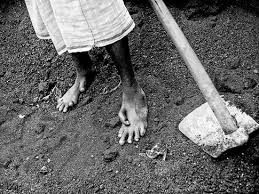PATNA: Some 21 years ago, Jharkhand based activist film maker Sri Prakash was doing the rounds with a video ‘Buddha weeps in Jadugoda’. It detailed the havoc being created by uranium mines in Jharkhand state. Now a Washington-based news organisation has released a report that claims radioactive and toxic waste have been leaking out of Jadugoda. It says that India’s oldest and most important uranium mine, is toxic to people, livestock, rivers, forests and agricultural produce in the area.
The unflattering report by journalist Adrian Levy for The Center for Public Integrity is the first of a four-part series critical of India’s nuclear programme.
The report accuses India’s nuclear establishment of systematically overlooking evidence that points to a radiation hazard at the Jaduguda uranium mine in Jharkhand’s East Singhbhum district. The authorities in India, have consistently being rubbishing local reports, and they’re debunking this one as well.
The Uranium Corporation of India Ltd (UCIL) has been operating the mine since 1967, extracting around 1,000 tonnes of uranium ore per day, which accounts for 20% of the raw material for India’s nuclear power generation. It has, however, remained closed since September 2014, following a Centre’s directive to suspend activity till UCIL’s lease is renewed.
The author claims to have seen a corporation report that said “1.5 tonnes of solid radioactive waste and 20,000 litres of liquid radioactive waste” had spilled from a new pipe, close to Jaduguda town, on April 10, 2007.
The report has a basis on accounts of locals and activists, studies that have come out since the 1990s and claims filed in court to say that mining has exposed workers and villagers to radiation, heavy metals and other carcinogens, including arsenic. Toxins leaching into underground aquifers and the Subarnarekha river could be contaminating the food chain, from fish to vegetables, it adds.
The UCIL and India’s Atomic Energy Commission have consistently refuted these claims and maintained that operations at Jaduguda are safe.
In August last year, the Jharkhand high court directed the Centre to set up an experts’ committee to examine the issue of radiation hazard at the mine. The court was responding to a PIL on the issue. Levy claims to have “reviewed hundreds of pages of personal testimony and clinical reports in the case that present a disturbing scenario”.
“The case files include epidemiological and medical surveys warning of a high incidence of infertility, birth defects and congenital illnesses among women living near the industry’s facilities. They also detail levels of radiation that in some places reach almost 60 times the safe levels… although India’s Atomic Energy Commission disputes these findings,” it says.
One of the “hard evidence of the toxic footprint” the report cites is a 2009 paper authored by a team lead by physicist Dipak Ghosh from Kolkata’s Jadavpur University. The study had collected water from the Subarnarekha river and adjacent wells, and found some of the samples had levels of radioactive alpha particles that were 160% higher than safe WHO’s safe limits.
Quoting the study, the report says adequate measures had not been taken to prevent toxic leaks from the site. Ghosh’s team had found the tailing ponds in the mine were neither lined with special material nor had a cap, which increased the chances of toxins leaching into the ground and into the air in the form of dust.
The report also details tests done by a Hiroaki Koide, a Japanese nuclear engineer who carried back samples from the area to Japan. Koide said radiation levels in villages close to the mines and in residential areas near the tailing ponds exceeded international safe limits by a factor of 10. The report says Koide also confirmed that uranium rock and finely ground mine tailings had been used as ballast for road leveling and house building.
The report also documents incidents of “radioactive leaks”, such as the bursting of a pipe carrying toxic slurry on December 24, 2006. It says the slurry poured into a tributary of the Subarnarekha for nine hours, “causing shoals of dead fish to float on the surface. No government investigation was undertaken”.


